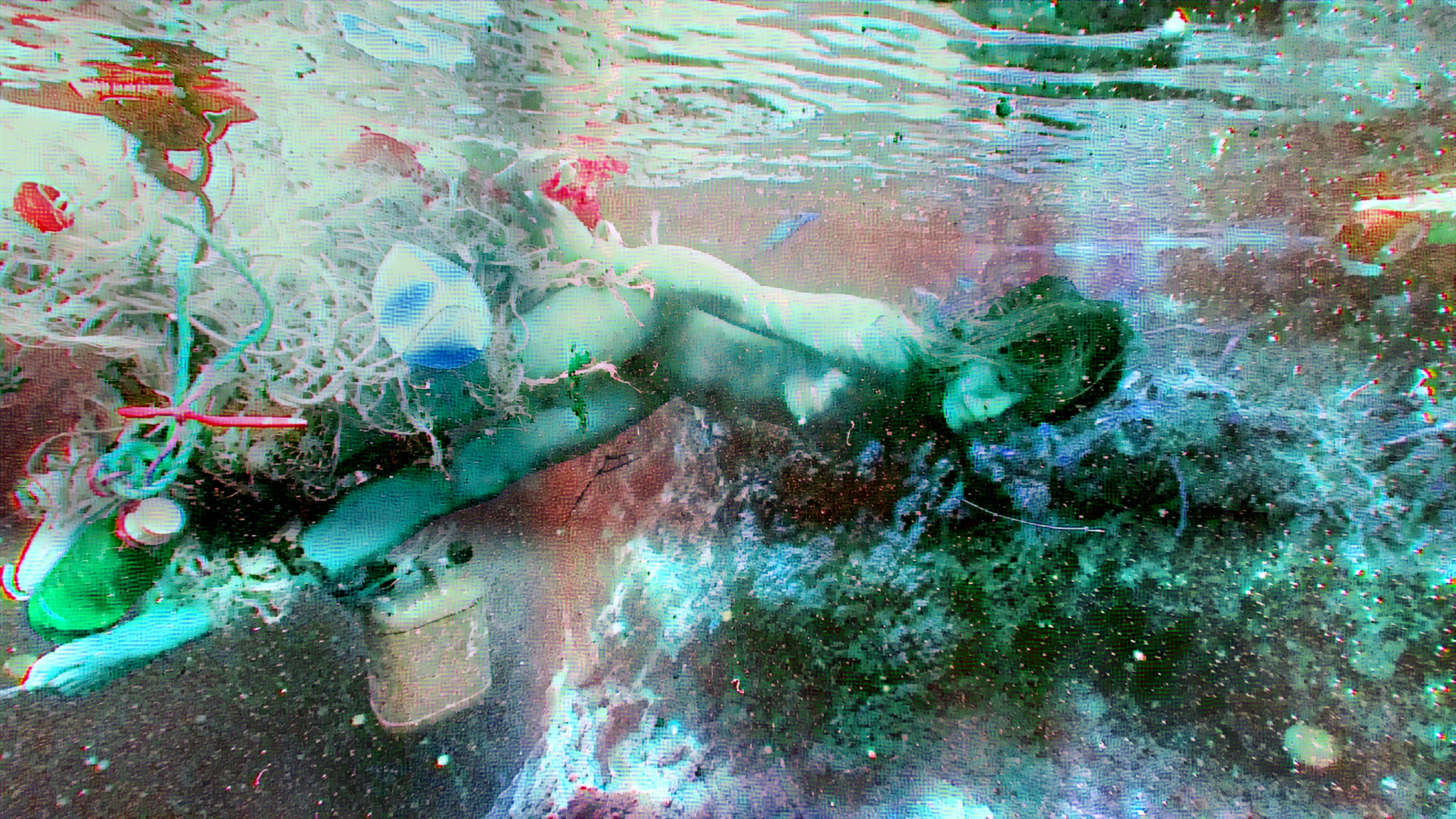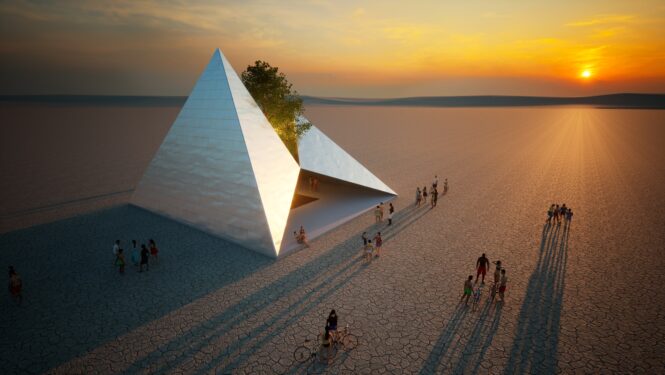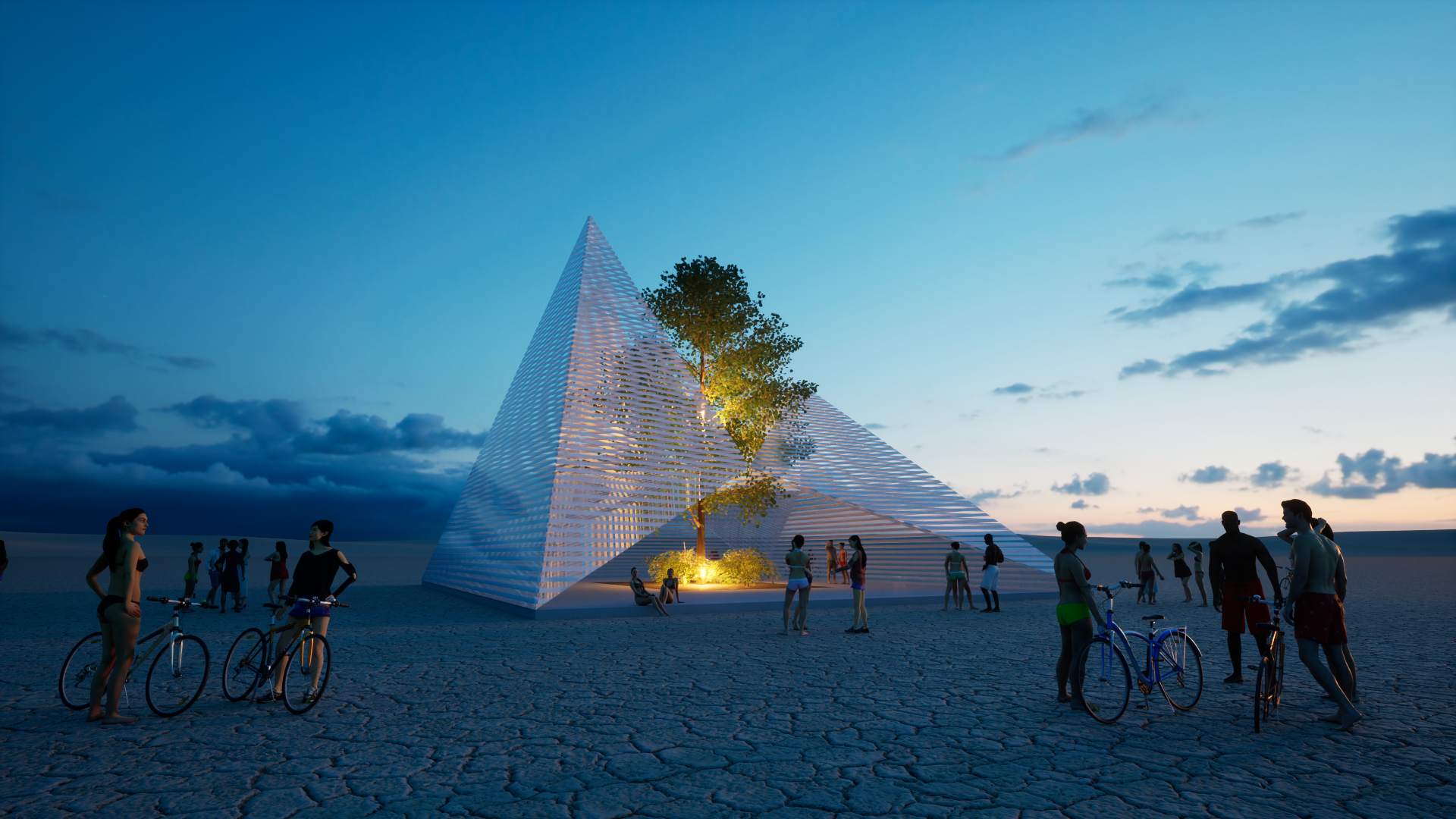Destined to rise in Black Rock City this year, “Sanctuaria” is a regenerative installation by the Sanctuaria Collective that will serve up shade and sanctuary in the desert. A metaphorical safe haven to all Animalia, “Sanctuaria” beckons to a simpler time when all we needed was air, water, food, shelter and each other. The piece brings together form and function—incorporating materials made from prevented ocean plastic, and generating power thanks to building-integrated photovoltaic tiles.
We spoke with Cecilia Pagkalinawan, the lead artist for “Sanctuaria” to hear about the powerful experiences that motivated her, and to learn about the art collective’s impetus and journey.
What inspired you to address environmental themes in your work?
Cecilia: I was born in the Philippines and left with my parents and four siblings when I was eight. As a small child, my favorite family vacations were spent on deserted islands; we’d be surrounded by jungle and nature and live totally off the grid. When I returned to those same Islands as an adult, I witnessed the deterioration of the waters where we used to swim. I was dismayed to see bleached and dead coral reefs and the expansion of plastic and garbage floating in the waters in Manila Bay, which used to be blue but now is a brackish gray.

As a parent and nature lover living in the US, I’ve been alarmed by the pace of global warming, wildfires, and drought that have affected millions of people around the world. Initially I felt powerless to affect and alter the changes in climate and human destruction I witnessed. After a spiritual ceremony in 2021, where I was outside, leaning against a tree, I received a message—either imagined or downloaded—stating: “You are being healed and spared so you can help and heal the earth and humanity.”
From there I started getting inspired to create art and communicate the fragility of the earth’s ecosystems. I would wake up from vivid dreams with ideas I wanted to execute. One of my earlier pieces “Trapped” consists of me swimming in ocean plastic that my friends Else Marie Keefe, Billy O’Brien and I found on the beach. I dreamed about creating the piece after doing a beach cleanup on World Oceans Day. “Trapped” was presented at NFTnyc’s “Diversity in Art” showcase and was projected at Arthur Mamou-Mani’s “Catharsis” at Burning Man 2022 along with Refik Anadol’s art.

In 2022 you got a glimpse into the experience of bringing art to Black Rock City when you volunteered for the ARTery. What was that like?
Burning Man 2022 was my first Burn where I was an empty nester. My son Mateo graduated in 2020 and is now studying architecture in college. I’ve been coming to Black Rock City since 2012, but 2022 was the first year I could stay through Burn Week. I volunteered on the ARTerian team giving art discovery bike tours. Through these I met many artists who inspired me—from Antwane Lee to Laura Kimpton. It was intense and tiring, but also beautiful and rewarding. I would head back to my camp, have dinner, fall asleep from exhaustion, then wake up for sunrise.
I read through descriptions and artist philosophies on almost 400 art submissions. I had to learn details about 88 Honoraria art installations for my tours and tried my best to engage art lovers and do justice to the artists who worked tirelessly on their installations. The team at the ARTery worked around the clock to assist in placement, installation, provide support, safety, and appreciation to 400 plus artists and thousands of builders who supported them.
I learned that bringing art to Burning Man is very democratic but can also be challenging. Many artists I’ve met were not trained artists and were just compelled to bring art as a gift to the playa and their Burner community. Many self-funded their projects and were in debt.
From there, you decided to create a regenerative art installation for Black Rock City. What was that journey like?
Regenerative works of art creatively incorporate features and technologies that restore natural ecosystems or provide ecological solutions. Art in itself can be beautiful, moving and thought provoking. Regenerative art can be all those AND have a purpose—enliven communities and benefit the land and earth around us. Along these lines, “Sanctuaria” will offer a photovoltaic facade and leaves that generate power for e-bike charging stations.
A big catalyst for me to create regenerative art this year was learning from Burning Man Project’s emissions inventory that every year Black Rock City participants generate more than 52,000 tonnes of carbon, and that the organization and community are actively working to reduce that. I wanted to create art that would drive awareness and also inspire others to join the effort to slow down climate change.
In 2022, I was caught in a dust storm by myself for three hours and got through it because I was offered water, shelter and gifts by strangers. These acts of kindness inspired me to pay it forward and create a quiet place where we can be shielded from the sun, protected from dust storms and also comfort one another. I kept waking up from dreams where I envisioned a cave structure and oasis that would shelter and comfort Animalia. Upon hearing of the Animalia theme, despite all that I know and understand of Burning Man art and artists, I took a leap.
Within a week I contacted and assembled a collective of people whose talents, spirit, and ethos I admire. Within two weeks, we submitted our application with our “Sanctuaria” concept. My son Mateo did the initial renderings during a week when he had classes and a job working 30 hours/week. Our design now includes a sculpture of an endangered rosewood tree, which will rise from the center of “Sanctuaria” as a symbol of our reverence and gratitude for nature.
Our team has grown to include artists, engineers, architects, and builders, all who are instrumental. Our installation is regenerative art with BIPV (building-integrated photovoltaics) as part of our facade and prevented ocean plastic as the source of our flooring and decorative features. Our advisors, Hermann and Dan, are innovators in the renewable energy space and have hundreds of patents between them. I’m blown away by how much thought, care, and hard work members of our team have done in terms of keeping the air we breathe clean and keeping plastics out of our oceans.
You’re working with Land Art Generator Initiative (LAGI), who recently collaborated with Fly Ranch for the LAGI 2020 Fly Ranch Design Challenge. How did that collaboration come together?
I sent a cold email to Robert and Elizabeth of LAGI, a leading think tank in regenerative art and architecture, after reading one of their blog posts on BIPVs (building-integrated photovoltaics). I was delighted when they wrote back and said that they wanted to advise our “Sanctuaria” team and introduce us to innovative solar technology providers. Their guidance on this journey has been invaluable and they are now our fiscal sponsor.
Tell us more about the technical aspects of “Sanctuaria.”
As an added gift to the playa, our organic PV tiles will hopefully generate enough power to support e-bike charging stations, so those who make it out to deep playa and find us can rest, recharge, then continue on their way. We’re creating irradiation models factoring in sun position and strength in Black Rock City during Burn Week, and also preparing for a potential reduction of solar draw from excessive dust. Extreme temperatures and weather are a reality now for many inhabitants of our planet so it’s important for our team to be mindful of that as we create art integrated with cutting edge technology for those beyond our Burning Man community to enjoy.
How can the community support “Sanctuaria?”
To get involved with “Sanctuaria,” please don’t hesitate to contact me or our team. We began our crowdfunding campaign on Earth Day to bring “Sanctuaria” to the playa and we would love your support. Donations to “Sanctuaria” will be received by LAGI and are tax deductible. They’ll go towards purchasing building materials, electronics, batteries and inverters for our solar system, photovoltaic tiles, lighting and sound systems, and e-bike charging stations.
Beyond Black Rock City, Earth Guardians have offered a future home for “Sanctuaria” so we can continue our mission to advocate for reducing our carbon footprint, slowing global warming and supporting a circular economy. I’m excited that my son Mateo will be turning 21, coming to his first Burn, and will be helping us build on the playa. We’re also seeking volunteers with a similar ethos for our build team. If “Sanctuaria” resonates with you, fill out the form on our website. Much much gratitude for this opportunity. Salamat. (Thank you in Filipino).
Cover image of “Sanctuaria” by the Sanctuaria Collective (Rendering courtesy of Sanctuaria)



What an amazing piece. I’m looking forward to checking it out and serving coffee and tea by it!
Report comment
Comments are closed.